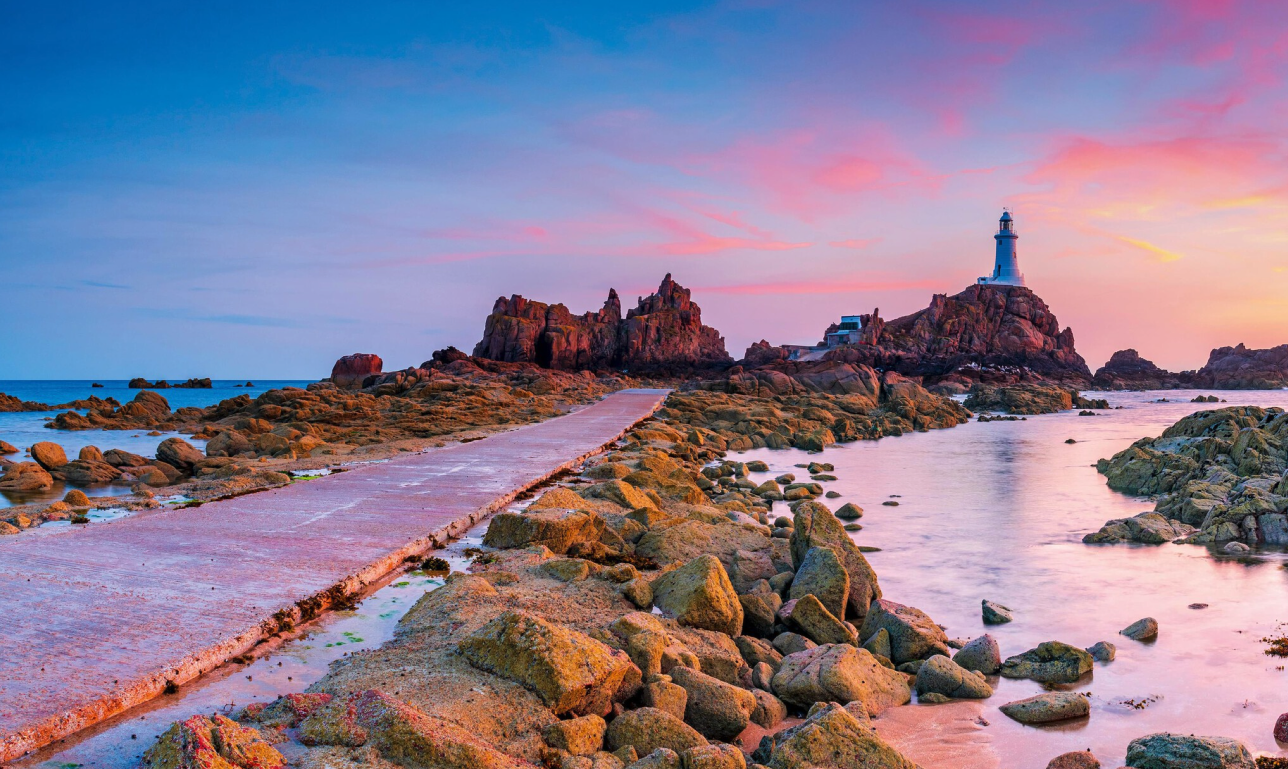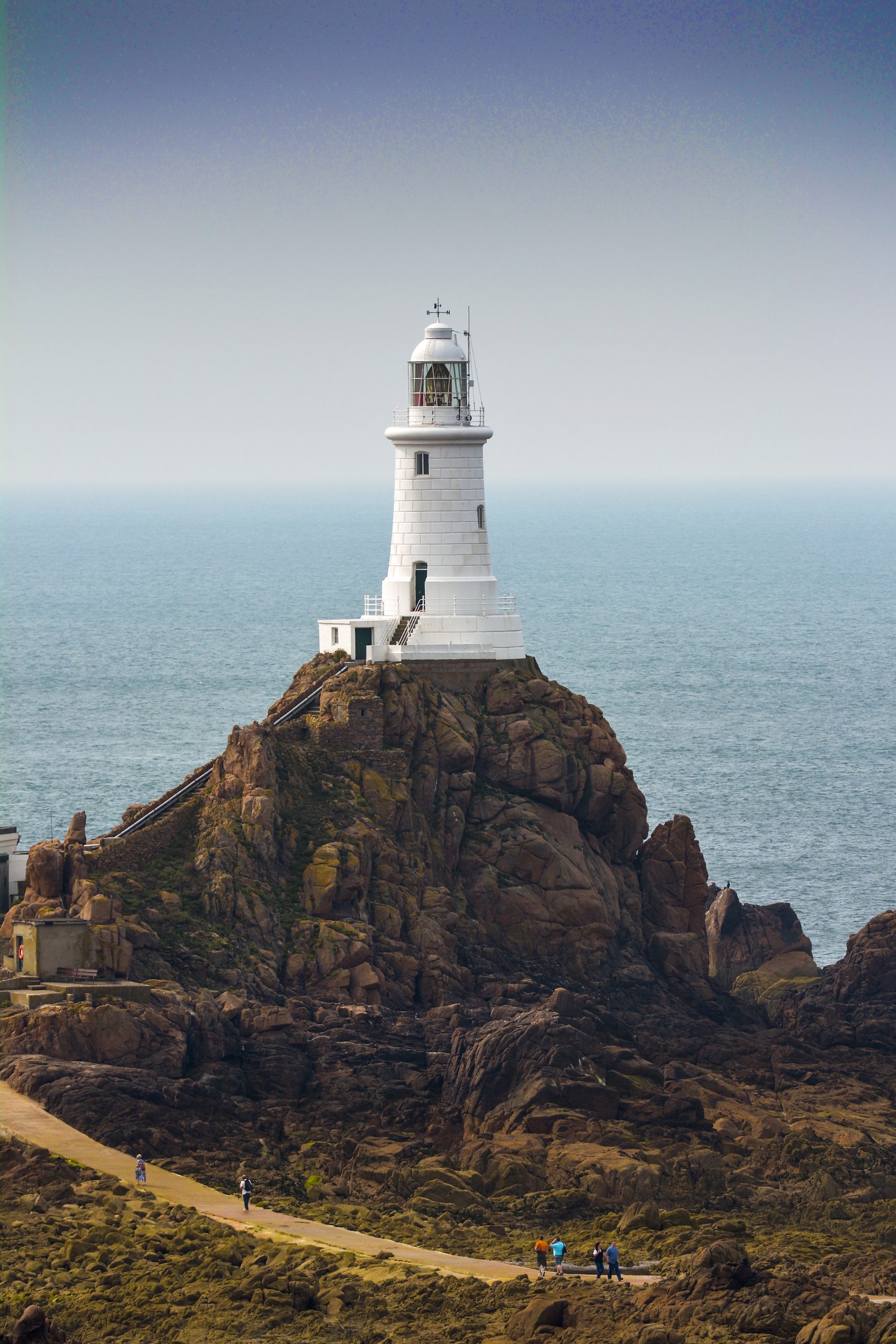La Corbière lighthouse: How 'the herdsman of the waves' has protected the Channel for 150 years
A feat of pioneering Victorian engineering, La Corbière lighthouse has guided seafarers to safety for 150 years, finds Antonia Windsor.


Perched majestically on a rocky outcrop, La Corbière lighthouse has been a steadfast guardian of the treacherous waters around the south-western tip of Jersey since 1874. Designed by civil engineer Sir John Coode (1816–92), the 62ft-high structure was the first lighthouse in the British Isles to be built from concrete. This innovation in construction materials was groundbreaking at the time and has contributed to the structure’s remarkable durability and longevity.
The lighthouse’s name, La Corbière, is derived from the Jèrriais word for ‘a place where crows gather’. Perhaps a reference to the black rocks that surround the area or referencing its sense of foreboding, the name nods to the formidable challenges posed by this part of Jersey’s coastline. A painting in the town hall in St Helier by the Channel Island artist James Finucane Draper (1836–76) titled Corbière Rocks depicts the site as it was before the lighthouse was built: jagged rocks set against the backdrop of a stormy sky. The French writer Victor Hugo, who spent some time on the island before the lighthouse was built, would go on to describe the concrete structure as ‘the herdsman of the waves’.
La Corbière’s story began in the mid 19th century, a time when maritime navigation was fraught with peril. The waters around Jersey, known for their strong currents and hidden reefs, claimed numerous ships and lives. The need for reliable navigational aid was desperate and conversations began about building a lighthouse. Before building commenced, the Jersey Government bought the headland to gain access to the foreshore and plans were drawn up by Sir John, who had been knighted in 1872 for his work on Portland Harbour in Dorset. The resident Jersey engineer was Imrie Bell, who had already worked on important civil-engineering projects on the island, including the breakwater at Elizabeth Castle and La Collette Harbour.

‘Drawings from the time show that the lighthouse was built from the sea, with barges coming in from St Helier and men removing the materials in wheelbarrows,’ reveals Jersey Blue Badge Guide Sue Hardy, who used to conduct guided tours of the lighthouse. ‘The concrete was then mixed and poured in situ into moulds as the tower was raised.’
Ms Hardy explains that Bell wrote a detailed guide to the building of the lighthouse in which he explains the process: ‘It was quite a scientific exercise. All the moulds were carefully crafted by carpenters on site and the interior was coated with a soapy emulsion, so that the concrete didn’t stick.’
Last to be built were the steps up to the lighthouse and the 984ft causeway from the shore (which is covered when the tide is high). ‘Of course, they didn’t need the steps or the causeway until the end,’ says Ms Hardy, ‘as they were building from the sea.’
On April 24, 1874, the lighthouse was lit for the first time. The Illustrated London News reported that ‘the expeditious performance of [its construction] is due in great part to the use of concrete as the material for the tower. It is the first, but assuredly will not be the last, work of this kind executed in this excellent constructive material’.
Sign up for the Country Life Newsletter
Exquisite houses, the beauty of Nature, and how to get the most from your life, straight to your inbox.
The original lamp was a three-wick paraffin lamp and for more than 100 years lighthouse keepers manned the tower and signalled ship movements: first by flag, then Morse Code, then by radio and finally by telephone. The lighthouse became fully automated in 1976, eliminating the need for a keeper and it now contains radar navigational technology, leading to the retirement of the old booming foghorn.
La Corbière’s influence extends beyond its practical functions. It has become an integral part of Jersey’s cultural heritage and its prominence is reflected in the Jèrriais language, where it has given rise to several proverbial expressions. Phrases such as j’avons pâssé La Corbiéthe (the worst is over) and il a pâssé hardi dg’ieau l’tou d’La Corbiéthe (that’s water under the bridge) underpin the lighthouse’s symbolic significance within the local community. It’s a popular destination for both locals and tourists, too, who like to walk the causeway at low tide, following in the footsteps of the keepers who once maintained the light.
In honour of the anniversary, the lighthouse has been given a new lick of paint (white paint serves as a daytime beacon to ships) and, for several weeks, it was floodlit, causing traffic to snake for miles as locals came to view the landmark looking grander than ever before.
Country Life is unlike any other magazine: the only glossy weekly on the newsstand and the only magazine that has been guest-edited by HRH The King not once, but twice. It is a celebration of modern rural life and all its diverse joys and pleasures — that was first published in Queen Victoria's Diamond Jubilee year. Our eclectic mixture of witty and informative content — from the most up-to-date property news and commentary and a coveted glimpse inside some of the UK's best houses and gardens, to gardening, the arts and interior design, written by experts in their field — still cannot be found in print or online, anywhere else.
-
 Some of the finest landscapes in the North of England with a 12-bedroom home attached
Some of the finest landscapes in the North of England with a 12-bedroom home attachedUpper House in Derbyshire shows why the Kinder landscape was worth fighting for.
By James Fisher
-
 The Great Gatsby, pugs and the Mitford sisters: Country Life Quiz of the Day, April 16, 2025
The Great Gatsby, pugs and the Mitford sisters: Country Life Quiz of the Day, April 16, 2025Wednesday's quiz tests your knowledge on literature, National Parks and weird body parts.
By Rosie Paterson